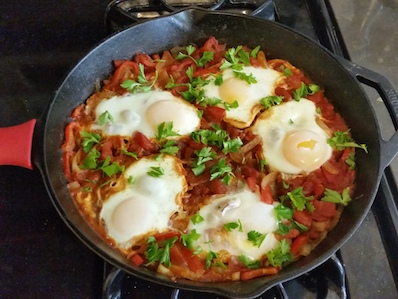Eggs in Purgatory

Eggs in Purgatory is an easy traditional dish from south Italy, where it's usually served as an entire meal. It's made from a savory, aromatic mix of kitchen basics, and is suitable for a meal any time of day. Consider seeking out the San Marzano variety of tomatoes (canned is fine) for their mild, mellow, and assertive taste. Preparation time required is short, maybe 30 mins.
The folk-tale about its name is that the eggs are the "souls" in the spicy, zesty red sauce that represents purgatory.
NYT Cooking editor Melissa Clark, from whom I've borrowed her
version of the recipe, notes that anchovies are not a traditional
ingredient, and can certainly be omitted if you prefer.
Yields: 3 to 4 servings
Ingredients:
- 2 Tbsp.1 extra-virgin olive oil, plus some for drizzling on toast
- 2 lg. cloves garlic, 1 thinly sliced, 1 halved
- (optional) 3 anchovy fillets, minced
- pinch of chili-pepper flakes, more to taste and for serving
- 1 28 oz. can diced tomatoes
- ½ tsp. fine salt, more to taste
- ¼ tsp. black pepper
- 1 lg. sprig fresh rosemary or basil, or a pinch dried rosemary
- 2 Tbsp. grated Parmesan cheese, more for serving
- 1 Tbsp. (14.2 g) unsalted butter, more to taste
- 6 eggs
- sliced crusty bread, for serving
- small handful chopped basil or parsley, for serving
Preparation:
In a large skillet with a lid, heat oil over medium heat. Add sliced garlic, anchovies, and chili-pepper flakes, and cook just until garlic turns golden brown at edges, about 1 min. Stir in tomatoes, salt, pepper and basil sprig, and turn heat to medium-low.
Simmer, squashing tomato pieces with a wooden spoon or a potato masher, until tomatoes break down and thicken into a sauce, 20 to 25 mins. Stir in Parmesan cheese, butter, salt, and chili-pepper flakes to taste.
Using back of a spoon, make 6 divots into tomato sauce, then crack an egg into each divot. Cover pan and let cook until eggs are set to taste, about 2 to 3 mins. for runny yolks. (If pan isn't covered, the eggs won't cook through, so don't skip that step.)
While eggs are cooking, toast bread in a toaster, or under the broiler. Rub warm toast with the cut garlic clove, drizzle with oil, and sprinkle with salt.
To serve, sprinkle eggs with more Parmesan cheese and chopped herbs, then spoon onto plates or into shallow bowls. Serve with garlic toast and pass chili-pepper flakes at the table.
Chef's Notes:
It's been pointed out to me (thank you, Jane Mailander) that Shakshouka (Magrebi Arabic for "a mixture") is a similar traditional dish, from the Magreb region of North Africa — so it may be that southern Italians should say "shukran" (شكراً) to North Africa.
However, that is, so to speak, the way of the world with recipes, where brilliant ideas spread worldwide and take many names. Consider: kiełbasa (Polish), klobása (Czech), ковбаса (Ukrainian), kolbász (Hungarian), klobasa (Slovenian), колбаса (Russian), klobása (Slovakian), Klobassa (Austria), kobasica (Serbian, Croatian, and Bosnian), kolbas (Bulgarian) — all the same thing, a cooked then smoked (or smoke-cooked) meat sausage, so-prepared to preserve it without needing refrigeration. All those names derive from the Turkish "kol basa", lit. "hand-pressed", or "kül basa", lit. "ash-pressed". Also basically the same thing, but differently named: szynkowa (Polish), Cervelat, Jagdwurst, and Weißwurst (German), landjäger (Finnish), hóng cháng 红肠 (Chinese), sucuk (Turkish), andouille and saucisse de Morteau (French), isterband (Swedish), and rookworst (Dutch).
1 Cups, tablespoons, and teaspoons are as defined in US Customary Units, not to be confused with differing British imperial, "legal", "coffee", Commonwealth of Nations, Canadian, Latin American, Japanese, Russian, or Dutch defintions — further proof that everyone needs the metric system.
Collected and re-published at http://linuxmafia.com/~rick/recipes/eggs-in-purgatory.html by Rick Moen <rick@linuxmafia.com> on Feb. 21, 2023. Individual recipes are free from copyright. Share and enjoy!
Grateful thanks to NYT Cooking editor Melissa Clark, who published this recipe. Friendly nod, also, to Steve Gray of Woodside, California, whose posting to Nextdoor inspired my seeking out a detailed recipe.
(If I have any copyright title in my own very minor contributions to this page — not my intention — they were created in 2023 by Rick Moen <rick@linuxmafia.com> and licensed for use under CC0. I have thereby waived all copyright, compilation copyright, and related or neighbouring rights to this work. This work is published from: United States of America.)
Image (used, here, unmodified) is © 2015 by Calliopejen1 (Jen), who licensed it for use under either GFDL 1.2 or later, or CC-BY-SA-3.0. My thanks for Jen's generosity.
(Jen's photo is actually of the similar Maghrebi dish Shakshouka.)
(Reminder: Creative Commons licences before v. 4.0, other than CC0, suffer an exploitable defect, and should not be used for new works. Reusers of works under the obsolete, defective licences should take care to make no mistakes in attribution.)
As GFDL 1.2 requires including an unaltered copy of the GFDL licence text with the covered work, and doing so for a photograph is absurd, the photo is being used, here, under CC-BY-SA-3.0 terms, not GFDL.